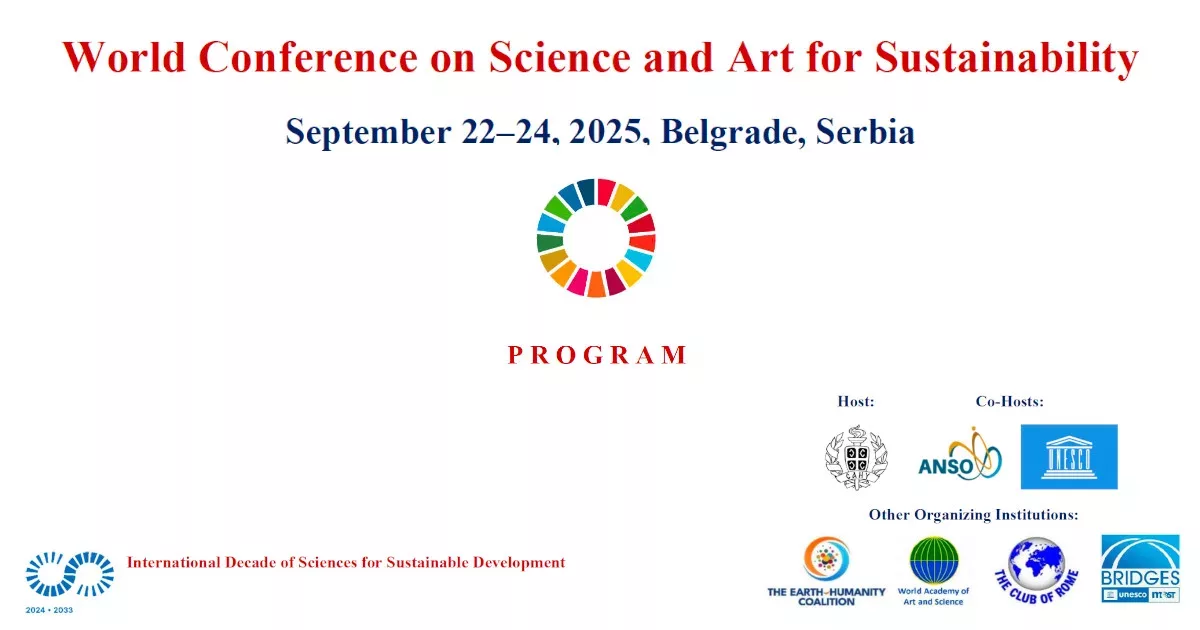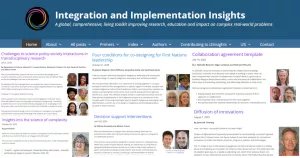World Conference on Science and Art for Sustainability
WAAS aims to develop novel ways of communication and cooperation between scientists, artists, policy-makers and all other science and art stakeholders

The World Conference on Science and Art for Sustainability, to be held on September 22–24, 2025 in Belgrade, Serbia, will be the second conference within the EHC-WAAS Program and a flagship event within the International Decade of Sciences for Sustainable Development (IDSSD). The aims of this Conference are to listen to prominent individuals acting in different science and art disciplines and coming from different parts of the world, to induce fruitful interactions among them, and to deduce from all that some concrete conclusions on the contributions of science and art to sustainable, secure, and peaceful development to be presented to the interested policy-makers and other science and art stakeholders at the local, national, regional, and global scales.
Pathways towards regeneration and sustainability
The integral goal of IDSSD is to significantly contribute to tracing the pathways towards regeneration and sustainability of nature and society as well as human security and peace. This should be done following eight Human Security Dimensions (HSDs), specified by the UN Development Programme (UNDP) in January 1994 and September 2022, and 17 Sustainable Development Goals (SDGs), defined by the UN General Assembly in September 2015.
These dimensions and goals are related to the existential problems and challenges facing the Earth and humanity today, which are: depletion of natural resources; climate change, pollution, and biodiversity loss; intercultural conflicts, forced migrations, and wars; human inequality and inequity. Today, it is clear that these problems have complex and multiple disciplinary character while the efforts of scientific communities worldwide are mostly limited to separated disciplines. In addition, the problems are interdependent and can mutually reinforce each other.
Therefore, a systemic and multiple disciplinary approach in looking for and finding their solutions is necessary. However, the current state of affairs is such that serious concerns about the ability of humankind to carry out the SDGs and HSDs by 2030, аs it was planned, are raised.
Within WAAS-EHC Program
The Earth-Humanity Coalition was founded with the task to prepare and implement, in close cooperation with UNESCO, various initiatives within the overall IDSSD program. The first of these initiatives was the EHC-WAAS Program of Sciences for Sustainable Development, which had been prepared by WAAS. It currently includes two series of webinars, six world conferences, a number of journal articles and reports, and four platforms in science and technology for cooperation between the Global North and the Global South.
The EHC-WAAS Program is based on the conviction that acquiring knowledge along the chain of basic, applied, social, and humanistic disciplines by scientific and technological communities worldwide within the disciplinary boundaries must be supplemented with their transdisciplinary efforts, and that the realization of the resulting agendas must be going on in a well-coordinated way. This endeavor also includes local and national traditional knowledge and its interactions with contemporary science and technology generated knowledge. One of the main aims of the Program is to enable the establishment of a solid foundation for the advancements of innovation, technology, education, agriculture, and industry towards sustainable, secure, and peaceful development at the local, national, regional, and global scales.
Besides, in the Program, relations between science and art are underlined, as between two distinct but complementary methods of inquiry about nature, society, and human beings with the same aim – to unravel the sense of the universe and communicate their findings to others. The results of science, being objective, and the results of art, being subjective, should influence and enrich one another, and thus push farther the boundaries of a true and deep understanding of the universe.
The EHC-WAAS Program should be applied worldwide, in both the Global North and the Global South, and in their cooperation following the principles of multilateralism, guaranteeing the respect of rights of every country in every domain, and the objective to make the Earth an equitably habitable planet that upholds well-being and justice for all.
Novel ways of communication and cooperation
It is well known that relationships between scientists and artists on the one side and policy-makers and all other science and art stakeholders in the public and private sectors on the other side are characterized by a lack of respect and trust. Therefore, the EHC-WAAS Program includes a strong request that novel ways of communication and cooperation of the two sides, based on sincere mutual respect and trust, must be developed and nurtured. The aim is to overcome the barriers that prevent these interactions as well as to effectively use the levers that stimulate them.
This should lead to the evolution of these communications from the one-sided and market-driven ones to a wide-participatory co-creation of approaches and agendas of science, technology, art, and education driven by the societally relevant problems and challenges. Besides, all three pillars of science and art diplomacy, being science and art for diplomacy, science and art in diplomacy, and diplomacy for science and art, should be continually used. These pillars cover the soft power of science and art to improve relations between countries even where official relations are strained or severed, the ways how science and art achievements help inform diplomatic objectives and foreign policy, and the ability of diplomacy to facilitate cooperation in science and art across borders, respectively.
Read the programme of the September 22–24, 2025 conference (PDF file).
SUBSCRIBE TO OUR NEWSLETTER
To stay up to date with our projects and the development of the EHC
Read more articles

Dealing with the complexity of society and environment
A global toolkit for tackling complex problems with more than 600 different methods Ever wish you had a free toolkit

The Moon & the Global South: Voices, Risks & Promise
Researchers warn that without inclusive governance, the Moon could become “a new arena for old patterns of exclusion” When rockets

Borko Furht: “AI shouldn’t be given much autonomy without maintaining accountability”
Beyond Superintelligence: The Real Challenges of Keeping Humans ‘In the Loop’ Borko Furht is a professor in the department of

The Belgrade Declaration on Science and Art for Sustainability
The Declaration was prepared as the principal outcome of the World Conference on Science and Art for Sustainability, held in